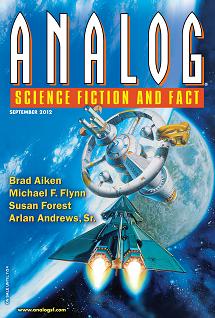
Analog, September 2012
Reviewed by Chuck Rothman
It’s been a very long time since I read an entire issue of Analog. I think it was even back when John W. Campbell was still editor. It never was exactly my cup of Oolong, and I wondered what it might be up to these days.
The stories in the September issue are all, in one way or another, mysteries: something unforeseen happens and the main character goes on to figure out the cause and what it means.
The issue starts out with “Done That, Never Been There” by Brad Aiken. Dr. Roger Bennett had achieved some fame by performing a (very) long distance operation by remote control to save one of the members of the first moon expedition. In the course of a routine interview, an attempt is made on his life, and he soon becomes the target of someone who wants to destroy all records of that operation, and kill him in the process. Aiken’s story is a fast-paced adventure that draws you in nicely, though I did find the motive for it all a little bit far-fetched.
Michael F. Flynn contributes, “Elmira, 1895,” which can be summed up as “Rudyard Kipling meets Mark Twain.” Kipling visits Twain in Elmira because he has come across some disturbing news articles about a mysterious ship in the sky that may be heading there. I liked the portrayal of the two men, and also the revelation of what Twain knows, which has some serious implications for the future. Even the gimmick of having the two men meet has a serious point.
January hears “The Voices” in her head and is sure she is suffering from schizophrenia. She undergoes a new treatment, hoping to cure herself, despite the fact that the voices are all perfectly reasonable and even friendly. This being a science fiction magazine, you can bet that this isn’t simple schizophrenia. Alec Nevala-Lee‘s story is as close to fantasy as it can be without going over the line, but the story is simply a revelation. The mystery is solved, but it would have been more interesting to see what happened next.
Susan Forrest‘s “A Rent in Space” is a humorous look at Willy Kavenaugh, a down-on-his-luck scientist who discovers a warp in the space-time continuum in his living room. The authorities won’t believe him until the shady scientist Bernard Bester starts nosing around with a way to take advantage. The story is too mild to be really funny: at best, it may make you smile, but it won’t make you laugh. It also goes on too long for the concept and spends too much time explaining the science when it should be moving the plot along faster.
“Mythunderstanding” by Carl Frederick is a scientific puzzle tale, though it first looks like it’s going in a different direction. Roger is an agent for the Angloterran Trade Agency, but he’s on Earth, touring the monastery of the Appelonians, a religious order loosely based on Johnny Appleseed. He discovers one planet where they sent their missionaries is rich in osmium, and rushes there for a trade agreement. But the Appelonians are there first, and there’s a question as to whether the natives are sentient enough to sign any agreement. The story is well constructed, if talky. Not much is done with the Appelonians, other than them being a competitor for the wealth, as the story slowly reveals the puzzle and then solves it.
“The Long View” shows David, an extremely wealthy man who is using his money to land on the moon once again, in order to place a time capsule as a memorial to humanity in case the Earth is destroyed. He finds something very surprising on the spot he has chosen. I found that Jerry Oltion‘s story gets bogged down on scientific and backstory minutiae, with David’s trek to the center of Tycho Crater shown in three pages of detail even though the story really doesn’t begin until he gets there. Once past that, though, the story comes through with a solid ending.
So, what are my impressions of Analog after all this time? First of all, everything here is well written and the stories all have good old-fashioned narrative hooks that make them good reads. The stories are all good entertainments with an attempt to make some philosophical points here and there. As mysteries, they end once the mystery is resolved. In some cases, that’s a good thing, but in others, I felt that solving the mystery does not end the story.
The characters are pretty simple, and certainly don’t suffer from any serious angst — which is both a good thing and a bad thing. I wished the characters were a bit more vivid, though. There’s also the phenomenon I’ve seen before in the magazine of explaining things for explanation’s sake, even when it’s not necessary for the story. Even with my reservations, though, there was plenty to like about the issue.